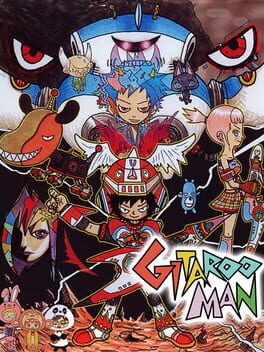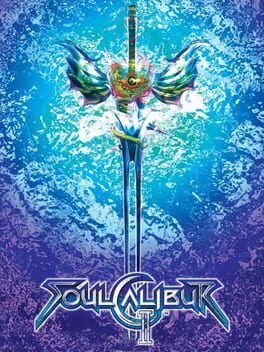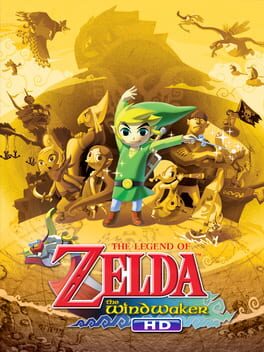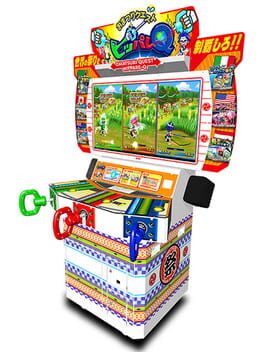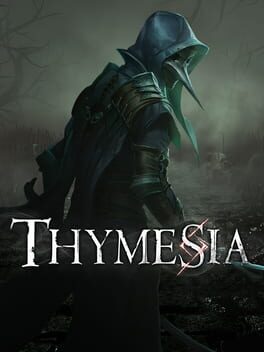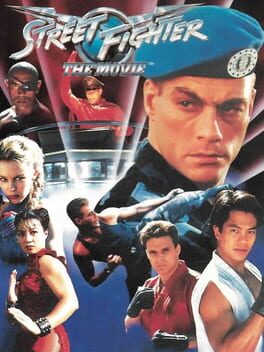CarnageKRool
Bio
Overall game enthusiast and fighting game specialist. I can't stop playing Tekken 8 help me.
Mario Hoops 3 on 3 is the hardest game ever created.
Overall game enthusiast and fighting game specialist. I can't stop playing Tekken 8 help me.
Mario Hoops 3 on 3 is the hardest game ever created.
Badges

Busy Day
Journaled 5+ games in a single day

GOTY '23
Participated in the 2023 Game of the Year Event

Shreked
Found the secret ogre page

Roadtrip
Voted for at least 3 features on the roadmap

2 Years of Service
Being part of the Backloggd community for 2 years

GOTY '22
Participated in the 2022 Game of the Year Event

Best Friends
Become mutual friends with at least 3 others

Liked
Gained 10+ total review likes

Noticed
Gained 3+ followers

Epic Gamer
Played 1000+ games

Elite Gamer
Played 500+ games

Gamer
Played 250+ games

N00b
Played 100+ games
Favorite Games
1680
Total Games Played
020
Played in 2024
014
Games Backloggd
Recently Played See More
Recently Reviewed See More
This is a decently fun remake of stages and bosses from the Megaman X (and occasionally classic) series interrupted by a really pointless and soulless currency/level up system that takes 10x as long as the actual stages do, even when you're cheating to avoid grinding. The amount of cool references and deep cut characters you can play as are what I can only describe as disappointingly bittersweet. Being able to play as Tron, Bass.exe, and Zero Nightmare is something I want from a real X game, but X9 this is not, and it's existence makes me doubt we'll ever see that game come to light.
Thymesia is a fairly clear meeting of Bloodborne and Sekiro. It's fast and aggressive, and encourages constant engagement rather than hiding behind a shield. Its parry mechanics and summoned weapons are familiar as well, and anyone who's played the samurai souls game will be instantly familiar. But there is a lot of downsides to this otherwise solid journey.
First things first, reading any review on here as well, it's quite obvious the level design is probably the biggest letdown of this game. There are 3 levels you explore total, with varying side missions within. Each of them feel sort of..unrealized, and maze-like. The starting forest is a sprawling tree house structure, with sprawling ramps and bridges, and the occasional big top. A lot of it looks the same, and the added N64/PS1 era fog doesn't help navigation any. The browns and yellows mush into something that's supposed to feel like a creepy funhouse among the trees, but ultimately fails to have any memorable landmarks or staying power in the mind.
The second level is easily the best of the 3 in the game, but that isn't exactly for the best reason. It is by far the most linear, and therefore easiest to navigate. The design itself is the easiest to remember and recognize for the most part, with each section of the level looking fairly unique, enough to recall where you've already been. The worst part of this stage would have to be the endlessly respawning blood enemies. They aren't particularly hard or anything, but how often they show up becomes more annoying that engaging. The only way to be rid of them constantly chasing you down is to find and kill the mini-boss controlling them.
The third level is what I would consider the most confusing to navigate. Being that its your basic castle and village setting, a lot of it inherently looks the same. But the real issue here, is the verticality. There are several places you have to climb up and down towers, with each floor having multiple doors and paths outward. Trying to keep straight which paths you've taken already and which floor leads to progression is actively frustrating.
As far as the actual gameplay goes, there are a few innovations to set it aside from the other 100 soulslike games that have dropped recently. If you've played any of these games, you know the drill. Hyper difficult action RPG with a punishing xp system that demands perfection, or your xp is forfeit. Like Sekiro, there is no stamina meter. Aside from the norms of this genre, the Wound system is the main gameplay gimmick. Basically, when damage is done to an enemy with your basic weapon, they don't lose health, per se. Their health bar will have sections of it turn green, indicating the wounds they have. When wounded, enemies are vulnerable to Claw attacks, which chip away at the green health, to truly do damage. Enemies will have their green health return to normal health over time, so they can no longer be Claw attacked, if left alone for too long. This encourages constant aggression and attacking. When the enemy is out of health, you can perform a finisher on them. The strangest part of this system is that, unlike most souls games, it works against the player. The player takes damage as usual, no green bar, no Claw attacks. In a game like Bloodborne, it's unique gimmick is regaining recently lost health by attacking, encouraging aggression that way. But only the player has that ability in Bloodborne. It feels unusual that the player in an already punishing genre, has to take down what is essentially 2 different health bars to win, when they can be defeated in a few hits. It isn't as hard or relentless as it sounds in the long run, it was just a strange choice to only make it work against you.
Other gimmicks of Thymesia combat include a parry system, which if you've played Sekiro it works mostly the same here. Press guard at the same time as an enemy attacks you, and you do green damage to them. There are some key differences though. For one, there is no blocking in this game. If you miss a parry, you cannot hold down the button and take some chip damage, you simply get hit. Another strange difference, is that small enemies to not enter any kind of a vulnerable state when being parried. They will continue to attack until the animation is done, so parrying only one attack won't cut it. Both of these differences play a key role in why most players tend to ignore parrying altogether. It's much more punishing and difficult than Sekiro, an already very difficult system in that game. Dodging is simply easier and more reliable in the long run, but there is a definite downside to relying on it alone. The games enemies are built around parrying, there is no way around it. Every enemy right down to the bosses, have a very rhythmic way of attacking you, and a very limited moveset. It's never unreasonable to pay attention enough to these enemies and memorize their patterns, especially since there are so few enemy types in the game, you'll be seeing the same exact sword and shield weilding footsoldiers the entire game. On top of that, parrying is downright better to do, since it does damage to the enemies, opening them up for Claw attacks. You can interrupt your own attacks with parries, as well. Staying very close to your enemies and wailing on them, getting rid of their green health, whilst also parrying their attacks is the key to Thymesia.
The last combat mechanic to note is the other large draw to the game, Plague Weapons. Every single enemy in the game, including every boss, drops a Plague Weapon gem. The more gems you have, the more you can unlock/upgrade each Plague Weapon. These weapons come in all shapes and sizes. From buffs, to shields, to a health sapping scythe. They're all flashy, and probably the coolest looking part of Thymesia. Your second meter, below your health, is your energy. These weapons are what use that energy. For the most part, they are used like a skill. When you unlock a Plague Weapon, you can equip it to one of 2 slots, and by pressing a button, you can then use that weapon, spending energy. It will have a short cooldown, and can be used again. There is however, another mechanic with these weapons. If you hold down the Claw attack, and hit an enemy, you can steal their Plague Weapon. This is a one time use weapon that uses no energy, and is scaled to whatever level you have that particular Plague Weapon upgraded to. These weapons are, to simplify, horribly unbalanced. Some of them are borderline useless, and some of them (the bow) are gamebreakingly good. They do massive damage, both normal and Claw, to anything they hit. It won't be too long before you rely on them above most things.
Like most souls games, Thymesia uses xp to level up a few stats in order to grow stronger. Strength (sword damage), Vitality (health), and Plague. Plague is the most interesting of the 3, upgrading Plague Weapon and Claw damage both, and the one I would suggest upgrading for an easy time. Unlike most souls games however, this game has a proper skill tree. Every time you level up, you get a skill point to use on whatever skill you wish, limited to ones further down a specific tree. Much like some of the Plague Weapons, some of these are very unbalanced. A longer dodge is nice, but gaining health every time you hit enemies with Claw attacks, or kill them, will keep you alive seemingly forever. Several levels can be basically sprinted through without using a single health recovery item by simply killing everyone and keeping your health at max. Pair this with the Scythe Plague Weapon that steals massive amounts of health, and outside of bosses, you'll start ignoring your health items altogether.
Speaking of health items, the last major mechanic of Thymesia is the potion crafting and upgrading. Using items received from mini-bosses and bosses, you can upgrade how many uses a potion has, or how much health it restores. It also can be upgraded to increase the amount of ingredients you can use in a potion, which are used in Alchemy, the main draw of potion crafting. Using ingredients found on certain enemies, you will be able to buff your potions with unique effects and healing boosts. These last forever and do not consume your ingredients even when swapped out for another ingredient. When a combination of 3 specific ingredients are used, you can end up with a secret recipe. These recipes add yet another buff to your character every time a potion is used. One in particular is incredibly broken, and can boost you to max level in no time at all. The recipe you get when combining Thyme, Rosemary, and Mint boosts your xp gained by 10%, or so it says. There is at the time of this writing, a very bad bug with this 10% boost. Say you have 9000 souls at one time, and you kill and enemy that gives you 100 souls. The buff is supposed to give you a 10% boost, so 110 souls. Instead, it gives you 100 souls, plus 10% of whatever souls you currently have, which would be 900, therefore a single enemy giving you 1000 souls total. The more souls you currently have, the more broken this buff gets. Using lots of items that give you souls automatically will shoot your soul count up to the millions easily. I ended the game with 204,000,000 souls, and you only need 350,000 to reach max level.
The last thing I want to talk about are the enemies and bosses themselves. Most are your generic villagers and soldiers, easy to dodge, parry, and kill. There are harder variants around, that have a bit more health and a few more attacks. Every level has a few mini bosses, generally an even stronger version of a basic enemy, with even more health and even more moves. There isn't much to say about them beyond what I've already said. Fairly basic, mini-bosses being the most notable of any of them, which are heavily recycled through every level. Bosses are what shine in Thymesia, aside from a few gimmick fights that aren't really fights. (Dragon God from Demon's Souls is a good example of these fights) The actual bosses are otherwise fantastic, and easily my favorite part of the game. They may not have any groundbreaking designs, but they're fast paced, threatening, and challenging, without being too demanding. And I think that leads me to my absolute favorite part of Thymesia. It's the only soulslike that gets the weight of animations anywhere close to FromSoft levels of quality. Something every other soulslike struggles with, has to be animations. They try to mimic that very specific weight and rhythm every FromSoft game has, making their enemies intuitive to fight, being able to parry and dodge their attacks despite seeing them for the first time. Thymesia mimics this feeling better than any non FromSoft souls game. That being said, the balance of the game, or lack thereof, is obvious when completing a playthrough. The first boss of the first level, is probably the hardest time you'll have here. He is relentless, and has a second even harder phase, it feels like a very uphill battle, since you won't have access to any good Plague Weapons, and your potions will be base level. But the longer the game goes on, the easier it gets. Enemies become jokes, and bosses become minor step stones. And I think that sums up my feelings of Thymesia in general.
Thymesia is a fun romp through some less than amazing levels, not very memorable enemies, and great bosses. Ultimately, the lack of any balance the has game dominates how the second half plays out. Some potions and Plague Weapons absolutely trivialize the game, making it so you don't really rely on any high skill or carefully thought strategies. It feels much more soulslike at first, but the longer it goes on, the less threatened you'll be by everything that dares stand against the Plague Bow. For a $25 dollar price tag, I would probably suggest it to any Sekiro fans, given how similar the gameplay is, but if you're looking for a serious challenge, it just isn't here. With some unique gimmicks and fast paced combat, there are some cool moments with it, but I just don't see myself revisiting this game every year like I do with something as magical and memorable as Bloodborne. If you've got $25 to throw around and are just looking for a new game to blow 6 hours on, you could do a lot worse.
First things first, reading any review on here as well, it's quite obvious the level design is probably the biggest letdown of this game. There are 3 levels you explore total, with varying side missions within. Each of them feel sort of..unrealized, and maze-like. The starting forest is a sprawling tree house structure, with sprawling ramps and bridges, and the occasional big top. A lot of it looks the same, and the added N64/PS1 era fog doesn't help navigation any. The browns and yellows mush into something that's supposed to feel like a creepy funhouse among the trees, but ultimately fails to have any memorable landmarks or staying power in the mind.
The second level is easily the best of the 3 in the game, but that isn't exactly for the best reason. It is by far the most linear, and therefore easiest to navigate. The design itself is the easiest to remember and recognize for the most part, with each section of the level looking fairly unique, enough to recall where you've already been. The worst part of this stage would have to be the endlessly respawning blood enemies. They aren't particularly hard or anything, but how often they show up becomes more annoying that engaging. The only way to be rid of them constantly chasing you down is to find and kill the mini-boss controlling them.
The third level is what I would consider the most confusing to navigate. Being that its your basic castle and village setting, a lot of it inherently looks the same. But the real issue here, is the verticality. There are several places you have to climb up and down towers, with each floor having multiple doors and paths outward. Trying to keep straight which paths you've taken already and which floor leads to progression is actively frustrating.
As far as the actual gameplay goes, there are a few innovations to set it aside from the other 100 soulslike games that have dropped recently. If you've played any of these games, you know the drill. Hyper difficult action RPG with a punishing xp system that demands perfection, or your xp is forfeit. Like Sekiro, there is no stamina meter. Aside from the norms of this genre, the Wound system is the main gameplay gimmick. Basically, when damage is done to an enemy with your basic weapon, they don't lose health, per se. Their health bar will have sections of it turn green, indicating the wounds they have. When wounded, enemies are vulnerable to Claw attacks, which chip away at the green health, to truly do damage. Enemies will have their green health return to normal health over time, so they can no longer be Claw attacked, if left alone for too long. This encourages constant aggression and attacking. When the enemy is out of health, you can perform a finisher on them. The strangest part of this system is that, unlike most souls games, it works against the player. The player takes damage as usual, no green bar, no Claw attacks. In a game like Bloodborne, it's unique gimmick is regaining recently lost health by attacking, encouraging aggression that way. But only the player has that ability in Bloodborne. It feels unusual that the player in an already punishing genre, has to take down what is essentially 2 different health bars to win, when they can be defeated in a few hits. It isn't as hard or relentless as it sounds in the long run, it was just a strange choice to only make it work against you.
Other gimmicks of Thymesia combat include a parry system, which if you've played Sekiro it works mostly the same here. Press guard at the same time as an enemy attacks you, and you do green damage to them. There are some key differences though. For one, there is no blocking in this game. If you miss a parry, you cannot hold down the button and take some chip damage, you simply get hit. Another strange difference, is that small enemies to not enter any kind of a vulnerable state when being parried. They will continue to attack until the animation is done, so parrying only one attack won't cut it. Both of these differences play a key role in why most players tend to ignore parrying altogether. It's much more punishing and difficult than Sekiro, an already very difficult system in that game. Dodging is simply easier and more reliable in the long run, but there is a definite downside to relying on it alone. The games enemies are built around parrying, there is no way around it. Every enemy right down to the bosses, have a very rhythmic way of attacking you, and a very limited moveset. It's never unreasonable to pay attention enough to these enemies and memorize their patterns, especially since there are so few enemy types in the game, you'll be seeing the same exact sword and shield weilding footsoldiers the entire game. On top of that, parrying is downright better to do, since it does damage to the enemies, opening them up for Claw attacks. You can interrupt your own attacks with parries, as well. Staying very close to your enemies and wailing on them, getting rid of their green health, whilst also parrying their attacks is the key to Thymesia.
The last combat mechanic to note is the other large draw to the game, Plague Weapons. Every single enemy in the game, including every boss, drops a Plague Weapon gem. The more gems you have, the more you can unlock/upgrade each Plague Weapon. These weapons come in all shapes and sizes. From buffs, to shields, to a health sapping scythe. They're all flashy, and probably the coolest looking part of Thymesia. Your second meter, below your health, is your energy. These weapons are what use that energy. For the most part, they are used like a skill. When you unlock a Plague Weapon, you can equip it to one of 2 slots, and by pressing a button, you can then use that weapon, spending energy. It will have a short cooldown, and can be used again. There is however, another mechanic with these weapons. If you hold down the Claw attack, and hit an enemy, you can steal their Plague Weapon. This is a one time use weapon that uses no energy, and is scaled to whatever level you have that particular Plague Weapon upgraded to. These weapons are, to simplify, horribly unbalanced. Some of them are borderline useless, and some of them (the bow) are gamebreakingly good. They do massive damage, both normal and Claw, to anything they hit. It won't be too long before you rely on them above most things.
Like most souls games, Thymesia uses xp to level up a few stats in order to grow stronger. Strength (sword damage), Vitality (health), and Plague. Plague is the most interesting of the 3, upgrading Plague Weapon and Claw damage both, and the one I would suggest upgrading for an easy time. Unlike most souls games however, this game has a proper skill tree. Every time you level up, you get a skill point to use on whatever skill you wish, limited to ones further down a specific tree. Much like some of the Plague Weapons, some of these are very unbalanced. A longer dodge is nice, but gaining health every time you hit enemies with Claw attacks, or kill them, will keep you alive seemingly forever. Several levels can be basically sprinted through without using a single health recovery item by simply killing everyone and keeping your health at max. Pair this with the Scythe Plague Weapon that steals massive amounts of health, and outside of bosses, you'll start ignoring your health items altogether.
Speaking of health items, the last major mechanic of Thymesia is the potion crafting and upgrading. Using items received from mini-bosses and bosses, you can upgrade how many uses a potion has, or how much health it restores. It also can be upgraded to increase the amount of ingredients you can use in a potion, which are used in Alchemy, the main draw of potion crafting. Using ingredients found on certain enemies, you will be able to buff your potions with unique effects and healing boosts. These last forever and do not consume your ingredients even when swapped out for another ingredient. When a combination of 3 specific ingredients are used, you can end up with a secret recipe. These recipes add yet another buff to your character every time a potion is used. One in particular is incredibly broken, and can boost you to max level in no time at all. The recipe you get when combining Thyme, Rosemary, and Mint boosts your xp gained by 10%, or so it says. There is at the time of this writing, a very bad bug with this 10% boost. Say you have 9000 souls at one time, and you kill and enemy that gives you 100 souls. The buff is supposed to give you a 10% boost, so 110 souls. Instead, it gives you 100 souls, plus 10% of whatever souls you currently have, which would be 900, therefore a single enemy giving you 1000 souls total. The more souls you currently have, the more broken this buff gets. Using lots of items that give you souls automatically will shoot your soul count up to the millions easily. I ended the game with 204,000,000 souls, and you only need 350,000 to reach max level.
The last thing I want to talk about are the enemies and bosses themselves. Most are your generic villagers and soldiers, easy to dodge, parry, and kill. There are harder variants around, that have a bit more health and a few more attacks. Every level has a few mini bosses, generally an even stronger version of a basic enemy, with even more health and even more moves. There isn't much to say about them beyond what I've already said. Fairly basic, mini-bosses being the most notable of any of them, which are heavily recycled through every level. Bosses are what shine in Thymesia, aside from a few gimmick fights that aren't really fights. (Dragon God from Demon's Souls is a good example of these fights) The actual bosses are otherwise fantastic, and easily my favorite part of the game. They may not have any groundbreaking designs, but they're fast paced, threatening, and challenging, without being too demanding. And I think that leads me to my absolute favorite part of Thymesia. It's the only soulslike that gets the weight of animations anywhere close to FromSoft levels of quality. Something every other soulslike struggles with, has to be animations. They try to mimic that very specific weight and rhythm every FromSoft game has, making their enemies intuitive to fight, being able to parry and dodge their attacks despite seeing them for the first time. Thymesia mimics this feeling better than any non FromSoft souls game. That being said, the balance of the game, or lack thereof, is obvious when completing a playthrough. The first boss of the first level, is probably the hardest time you'll have here. He is relentless, and has a second even harder phase, it feels like a very uphill battle, since you won't have access to any good Plague Weapons, and your potions will be base level. But the longer the game goes on, the easier it gets. Enemies become jokes, and bosses become minor step stones. And I think that sums up my feelings of Thymesia in general.
Thymesia is a fun romp through some less than amazing levels, not very memorable enemies, and great bosses. Ultimately, the lack of any balance the has game dominates how the second half plays out. Some potions and Plague Weapons absolutely trivialize the game, making it so you don't really rely on any high skill or carefully thought strategies. It feels much more soulslike at first, but the longer it goes on, the less threatened you'll be by everything that dares stand against the Plague Bow. For a $25 dollar price tag, I would probably suggest it to any Sekiro fans, given how similar the gameplay is, but if you're looking for a serious challenge, it just isn't here. With some unique gimmicks and fast paced combat, there are some cool moments with it, but I just don't see myself revisiting this game every year like I do with something as magical and memorable as Bloodborne. If you've got $25 to throw around and are just looking for a new game to blow 6 hours on, you could do a lot worse.
